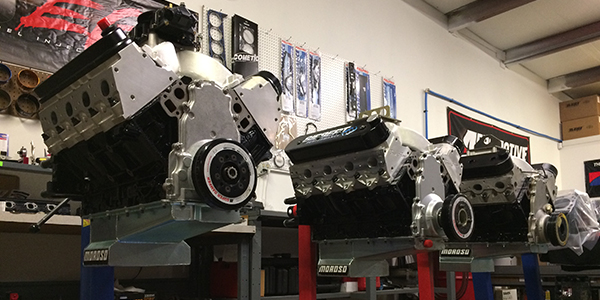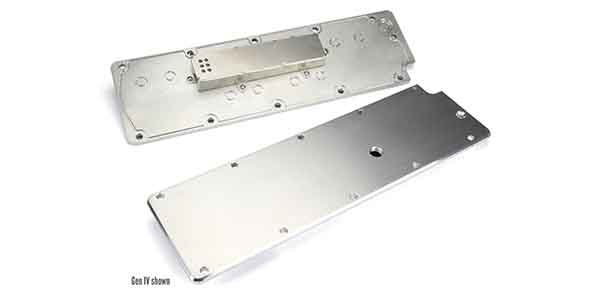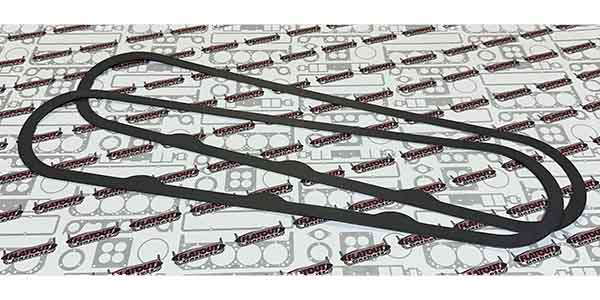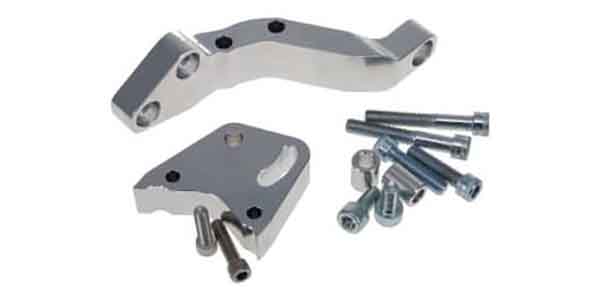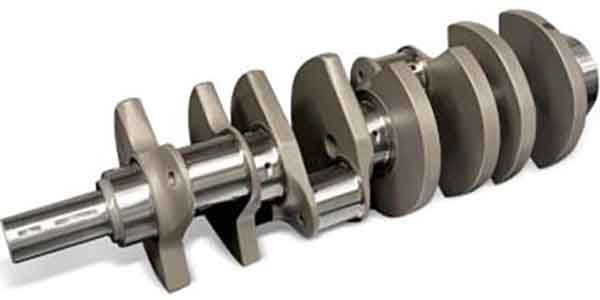As an engine builder and racer, I regularly hear racers discussing all the good things they hear about LS engines. However, I have noticed that there are a few things that seem to keep the racing crowd from making the switch from their old 23-degree small block to an LS series engine. Sometimes, it’s the initial financial investment to make the switch, or maybe it’s the fear of electronic fuel injection.
However, the most prevalent reason seems to be that those racers are leery of the unknown – these are not their tried and true small blocks, or they haven’t been educated on how these engines can be beneficial to their race program. In the rest of this article, I hope to help clear up some of these concerns, dispel some of these myths, and shed some light on what to look for when getting more cubic inches out of your LS engine.
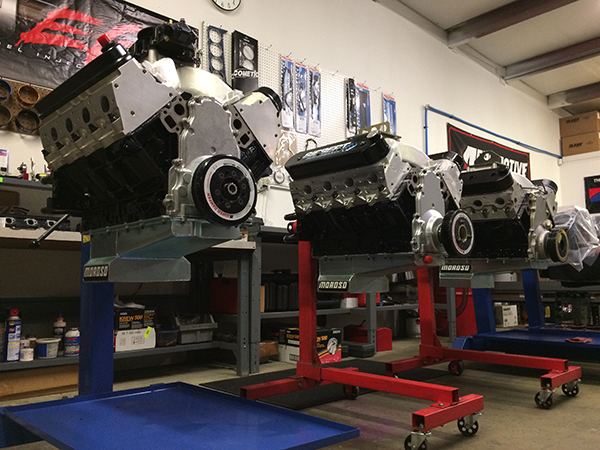
The LS is the third and fourth generation designs of the small block Chevrolet engine that was first released in the 1997 Corvette. In factory production form, this platform was available from 293 cubic inches to the 427 cubic inch LS7. Variations of these engines could be found in GM trucks and vans, F-bodies, Corvettes, and even performance sedans like the Pontiac G8 and Chevy SS.
These engines caught on quickly with the street performance and heads-up racing crowd because of their familiar, easy-to-work-on, overhead valve and pushrod design – just like the ever-so-popular small block and big block Chevy engines. Now, with General Motors rumored to be releasing multiple small displacement overhead cam engines in the next generation of Corvette, I am almost certain that the LS family of engines will be the last great pushrod V8 platform to be mass produced.
What is so great about these LS engines? First, the LS engine has multiple design features that help it achieve near-big-block levels of horsepower. With a 15-degree valve angle, intake ports that flow 300 cfm and a 55mm camshaft diameter, one can see what the engineers at GM were after when designing these engines – efficiency and performance. They share the same 4.400˝ bore spacing as a standard small block Chevy, but have a raised cam tunnel location, a near ¼-inch taller deck height, and a rigid 6-bolt main cap design.
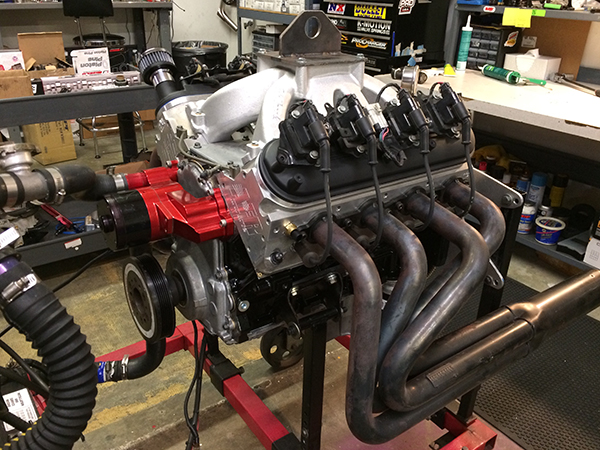
These engines were a 100% redesign of the Gen I and II small block. Designers literally took the good from its predecessor and rebuilt it from the ground up using 50 years of learned technology. Even though the external dimensions are small, 454 cubic inches can be easily obtained and heads flowing close to 400 cfm are readily available through several aftermarket companies. All of this makes it easier to achieve impressive power levels, while spending less money.
In my opinion, one of the best parts of the LS engine is the valvetrain. As I mentioned earlier, they sport a 55mm cam diameter, which makes for more gentle valve events. Even though a solid lifter camshaft will make more power, I still see most of our builds being centered around a hydraulic roller design. The large diameter hydraulic roller cam and the factory production rocker arms make for a light and stable valvetrain. All of this makes 7,800 rpm possible with a low maintenance hydraulic lifter valvetrain. So, what does that mean for the end user – the racer (and your customer)? It means hundreds of runs without needing to pull a valve cover, much less adjust valves.
So, what makes a LS engine a good candidate for building a “stroker” engine? In my opinion, there are two main considerations.
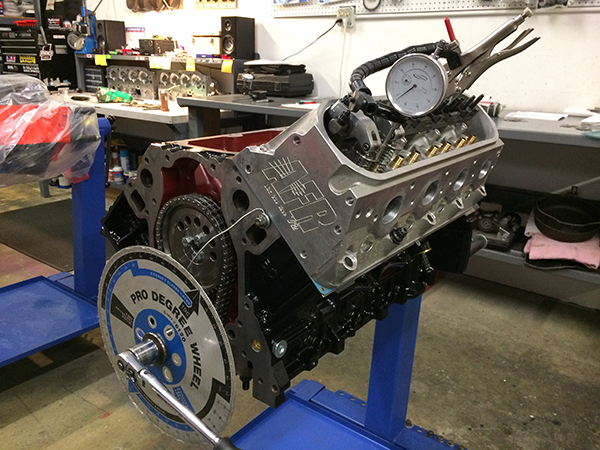
First, the capability of the cylinder heads that are available. With only mild porting, even popular factory casting cylinder heads like GM’s 243 LS6 or 823 LS3 castings can support an engine greater than 400 cubic inches with ease. And don’t forget, there is a vast array of aftermarket heads available as well.
Second is the raised cam tunnel center line from its small block predecessor. General Motors engineers stretched the Gen I small block’s cam height from 4.521˝ to the 4.890˝ for the LS platform. This means the days of machining your connecting rods to clear the camshaft on anything with a 3.750˝ or longer stroke are over! The LS design can take up to a 4.125˝ stroke without the need to clearance the rods for cam clearance.
Just how big can you go with your stroked LS? Aftermarket blocks are readily available with a 9.750˝ deck height – a 0.510˝ increase from the factory 9.240˝. Customers also have the option of a 0.390˝ raised cam height. Together, these features allow for an astounding 4.600˝ stroke that makes 500+ cubic inches possible.
For the purposes of this article, we’ll reference a recent build we had come through our shop, Siebert Performance in Topeka, KS. Our customer planned on using this engine to bracket race his 3,400-lb.Trans Am.

The first thing you need to do is select the parts you’ll use in your build. The obvious start to any engine build is selecting a good block that will meet your goals. To ensure you can meet those goals, you must know the limitations of the block as well as other components you will use.
For example, cylinder length and how it limits stroke, is one of the factors to consider when starting a build. The length of the cylinder is important because it dictates how much piston will be pulled out of the bore at bottom dead center. The shorter the cylinder, the harder it is to design a piston that maintains stability and ring seal at the bottom of the bore. As a rule of thumb, we like to stay with a maximum of a 4.000˝ stroke on any LS block with a cylinder length less than 5.600˝. This dimension is descriptive of all the factory blocks except the LS7, which has a 5.800˝ cylinder length.
For this build, we selected the most commonly used block and stroke combination when it comes to LS engines – the iron block 408. We felt 408 cubic inches were necessary to achieve our customer’s ET goals. We started with a LQ4/LQ9 iron GM 6.0L block. These blocks are commonly found in 2000-2006 GM full-sized trucks, vans and SUVs. In stock form, GM derives 6.0L, or 364 cubic inches, from a 4.000˝ bore and a 3.622˝ stroke crankshaft. While these dimensions allow for great performance, who doesn’t long for more horsepower and area under the curve on their dyno sheet?

Now that we have our block, we can focus on our rotating assembly. Increasing stroke is the most effective way to increase cubic inches on any given engine. Most of the popular crankshaft companies today offer forged LS crankshafts in varying levels of quality. For under $900, most companies offer a good, entry level 4340 forged crankshaft that will support up to 1,000 hp reliably. Many suppliers offer USA forged crankshafts in multiple variations that allow for strength and reliability when making horsepower north of 1,500.
For this particular engine build, we called our friends at Callies Performance to get our crankshaft and connecting rods. Their Compstar line of crankshafts and connecting rods seem like a good fit for our customer’s budget and expected power level. We selected a 4.000˝ stroke crankshaft and 6.125˝ length rods, dressed out with ARP2000 bolts. On top of the H-beam rods we place a set of 4.030˝ bore, 2618 alloy, Wiseco pistons with a 1.2mm, 1.2mm, 3mm Total Seal ring set. These pistons have a +5cc dome volume and bring our compression ratio up to 13:1.
Windage control is always important, especially on a LS engine where the crankcase area is somewhat lacking due to the Y-block design. To take advantage of the space we are given, we chose to go with a Moroso oil pan and windage tray combo. The Moroso pan does a good job of keeping oil in its place with the diamond-shaped trap door system in the sump, while the louvered windage tray is designed to clear our extra stroke and control windage more efficiently than the factory windage tray design. To power our oiling system, we chose a Melling high volume pump to keep the engine lubricated.

Now we need the top end of our engine. When choosing a proper cylinder head for a stroked LS engine, your customer may dream about installing the largest cylinder head available, however, this is most often the wrong way to go about getting the best performance. To pick the heads that are right for our build, first we must know the different configurations of LS heads that are available.
First is the original cathedral port configuration that was released on the 1997 Corvette LS1. Its same basic design carried on in cars and trucks with multiple iterations until about 2007. This velocity-efficient design is easily identified by its cathedral port opening shape. These heads in the aftermarket world are generally available with 2.100˝ or smaller intake valves and are well fit for a 4.080˝ and smaller bore block.
In 2007, General Motors introduced the rectangle port LS3 cylinder head design. In stock form, these heads have a significantly larger intake port with a 2.165˝ intake valve and a port volume that is over 60cc larger in volume than the cathedral port’s 198cc volume. These heads flow an amazing 312 cfm straight from the factory. You can see why these are a popular choice for racers and hotrodders alike. Because of their intake valve diameter, these heads are best fit for engines with 4.060˝ or larger bore sizes.
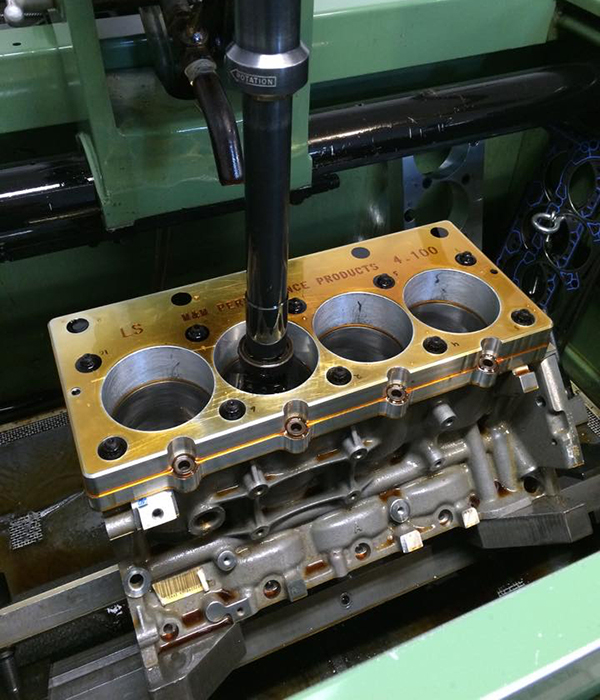
Derived from the C5R racing program, GM introduced the LS7 engine and cylinder head design in the 2006 model year Corvette Z06. This cylinder head design features a rectangle port inlet shape that is similar to the LS3, but is raised .100˝ and is 100% CNC ported. The 2.205˝ diameter intake valve is best fit for 4.125˝ and larger bores and helps this head flow over 370 cfm!
Aftermarket companies offer many variations of each head design, big or small. They are each popular in their own way as the general public commonly builds the LS platform from 300 cubic inches to over 500 cubic inches. For this build, we decided to go with a set of AFR 230cc cylinder heads. Their 328 cfm rating and 2.080˝/1.600˝ valve combination are a good fit for our 4.030˝ bore 408.
For the camshaft, we selected a COMP Cams hydraulic roller that provides 255 degrees of duration at .050˝ lift on the intake, and 263 degrees of duration at .050˝ lift on the exhaust. COMP Cams 1.7 ratio shaft rockers are used to compress the Manley Nextek polished dual valve springs that keep the valvetrain under control.
Now that we have our parts, we must make sure that they’ll all work well together. That means we need to do some machining for fitment of our components to make sure we have appropriate and consistent internal clearances.
Before starting any of the machining processes, we investigate what fasteners need to be replaced or improved over the factory design. Even though the LS design utilizes a 6-bolt main system, the standard 10mm bolt diameter isn’t typically up to the task of keeping the mains in place when trying to produce big block level power. To solve this problem, we select an ARP2000 main stud kit, allowing us to take full advantage of the 6-bolt main system.
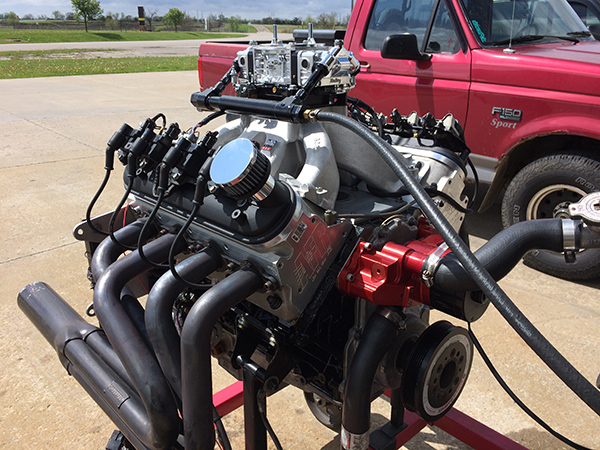
With a 4-bolt-per-cylinder 11mm head bolt design, head gasket sealing can become an issue in power adder applications, or even a naturally aspirated engine with compression ratios above 13:1. To alleviate this issue, we go with ARP’s standard 8740 material head stud kit. In extreme applications we move to their ARP2000 or CA-625+ material fasteners.
Once the fasteners are selected, it is time to start the machining processes. We start by line honing the main bores. Not only is this a necessity when the factory torque-to-yield bolts are changed out for studs, but we typically see the main bores distort after being run for years. After line honing, we place the block in our cylinder hone to take the cylinders to their desired dimension with a torque plate and proper fasteners in place.
Before balancing, we check the reluctor wheel placement on our LS crank with Goodson’s installation and alignment tool (pn-RRJ-350). Once the precision balancing process and parts weight matching is completed, we TIG weld the reluctor wheel to the crankshaft to prevent the wheel from rotating and impacting ignition timing.
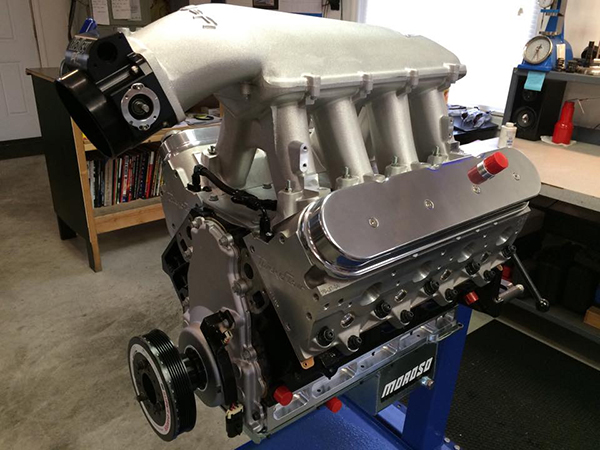
To finish the machining process, we mock-up our block with rods and pistons to measure deck height on the four corner cylinders of our block. We use this as a guideline, so we know how far to cut the deck surface on the block. Surfacing is always done using BHJ’s Block-Tru fixture to ensure that the decks are cut square and parallel to the main centerline.
Now that we’ve built our engine, we need to feed it. EFI or Carburetor? Electronic fuel injection technology has come a long way and with that, so has the ease of use.
Today, several choices of self-learning systems to help build base fuel maps for the system to work with are available. Basically, they’ve taken the hard work of tuning and simplified it to require only small changes to get you where you want to be. When using a turbocharger or centrifugal supercharger, EFI is the best way to go to keep an engine happy in all conditions.
Even though installing a carburetor on an engine originally equipped with EFI is considered by many to be sacrilege, I am still an advocate of using a carburetor in a naturally aspirated race combination. I still tend to see a carburetor make more horsepower and be easier to predict in varying weather conditions, while also being more cost effective.
General simplicity is also a large deciding factor, as EFI systems inherently cost significantly more money to piece together and install. For our customer’s application, we’ll specify a Siebert Performance Sportsman Series 850 cfm carburetor to allow for maximum horsepower and predictability at the track.
In summary, our manipulation of the available cubic inches that can be found in the LS series of engines allowed our customer the opportunity to obtain an engine that provides him with a myriad of benefits. He gained a high horsepower Stroker LS at a reasonable cost that will require little maintenance and provide great predictability. This will allow him to be competitive as a racer and very happy as a customer.
The parts combinations outlined in this article are descriptive of this engine only and are not the only choices you should consider. Your customer’s needs may vary. For more information on LS engine builds and the LS platform, search our detailed archives at www.EngineBuilderMag.com.

